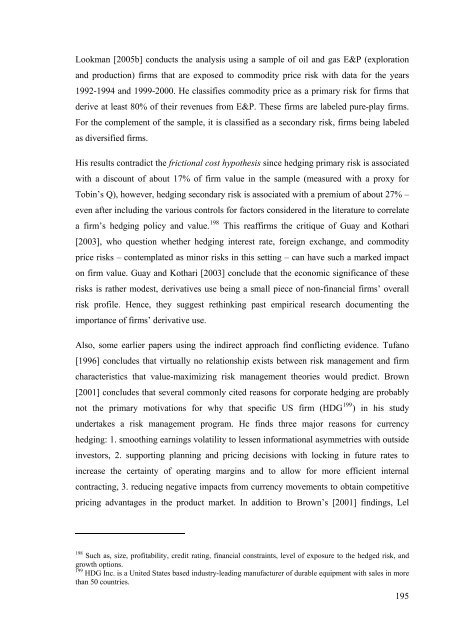értekezés - Budapesti Corvinus Egyetem
értekezés - Budapesti Corvinus Egyetem
értekezés - Budapesti Corvinus Egyetem
Create successful ePaper yourself
Turn your PDF publications into a flip-book with our unique Google optimized e-Paper software.
Lookman [2005b] conducts the analysis using a sample of oil and gas E&P (exploration<br />
and production) firms that are exposed to commodity price risk with data for the years<br />
1992-1994 and 1999-2000. He classifies commodity price as a primary risk for firms that<br />
derive at least 80% of their revenues from E&P. These firms are labeled pure-play firms.<br />
For the complement of the sample, it is classified as a secondary risk, firms being labeled<br />
as diversified firms.<br />
His results contradict the frictional cost hypothesis since hedging primary risk is associated<br />
with a discount of about 17% of firm value in the sample (measured with a proxy for<br />
Tobin’s Q), however, hedging secondary risk is associated with a premium of about 27% –<br />
even after including the various controls for factors considered in the literature to correlate<br />
a firm’s hedging policy and value. 198 This reaffirms the critique of Guay and Kothari<br />
[2003], who question whether hedging interest rate, foreign exchange, and commodity<br />
price risks – contemplated as minor risks in this setting – can have such a marked impact<br />
on firm value. Guay and Kothari [2003] conclude that the economic significance of these<br />
risks is rather modest, derivatives use being a small piece of non-financial firms’ overall<br />
risk profile. Hence, they suggest rethinking past empirical research documenting the<br />
importance of firms’ derivative use.<br />
Also, some earlier papers using the indirect approach find conflicting evidence. Tufano<br />
[1996] concludes that virtually no relationship exists between risk management and firm<br />
characteristics that value-maximizing risk management theories would predict. Brown<br />
[2001] concludes that several commonly cited reasons for corporate hedging are probably<br />
not the primary motivations for why that specific US firm (HDG 199 ) in his study<br />
undertakes a risk management program. He finds three major reasons for currency<br />
hedging: 1. smoothing earnings volatility to lessen informational asymmetries with outside<br />
investors, 2. supporting planning and pricing decisions with locking in future rates to<br />
increase the certainty of operating margins and to allow for more efficient internal<br />
contracting, 3. reducing negative impacts from currency movements to obtain competitive<br />
pricing advantages in the product market. In addition to Brown’s [2001] findings, Lel<br />
198 Such as, size, profitability, credit rating, financial constraints, level of exposure to the hedged risk, and<br />
growth options.<br />
199 HDG Inc. is a United States based industry-leading manufacturer of durable equipment with sales in more<br />
than 50 countries.<br />
195
















